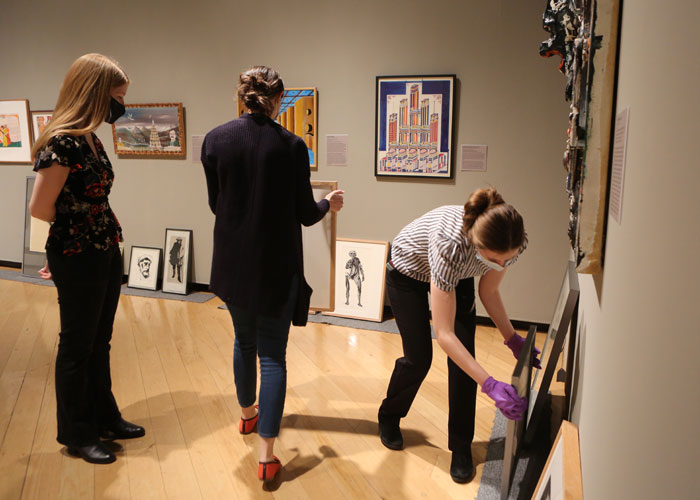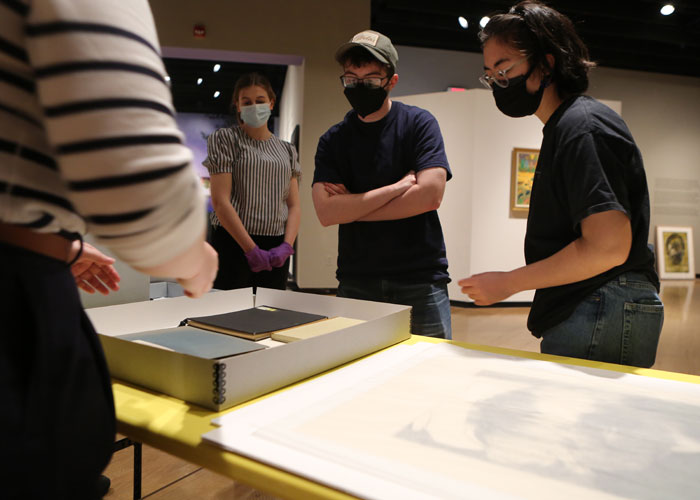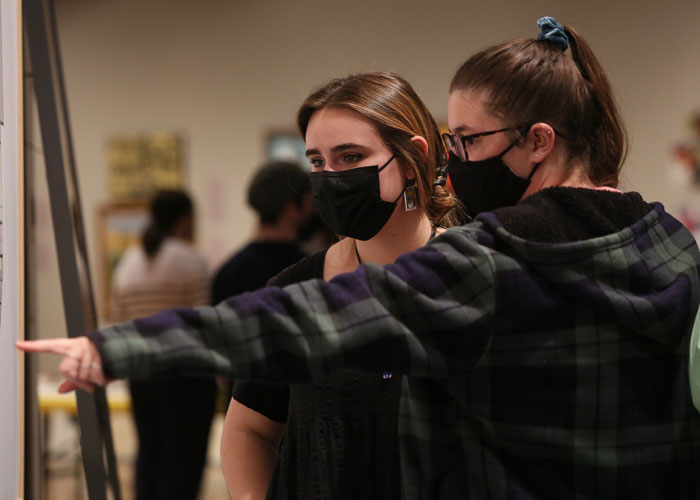Students curating a museum exhibition at William & Mary get the full experience.
This includes choosing artwork, writing accompanying text and deciding on placement in the gallery — all while working with the on-campus Muscarelle Museum of Art’s collection, galleries and curatorial staff.
“It’s a relatively new course in our curriculum — a response to our students’ interest in museum work and to the availability of the Muscarelle Museum of Art, our university museum, which takes very seriously its role as a laboratory for learning,” said Charles Palermo, professor of art history, who is teaching the course for the first time this semester as part of a rotation of faculty members who do so.

The Curatorial Project is a required practicum course for art history majors that is taught each spring in collaboration with the Muscarelle.
This year the coursework will culminate in the opening of “The Curatorial Project: Leonard Baskin” on April 15 at the Muscarelle. Students will give presentations there on April 25 at 3:30 p.m. as part of Undergraduate Research Month.
“I am thrilled to have the opportunity to get experience in a museum itself and outside of the classroom,” said Ivana Genov ’23. “Presenting at the Muscarelle is a great way for students to get familiar with the workings and environment of a museum and better understand the curatorial process. Additionally, the museum staff seems delighted to have us, (is) genuinely excited about our exhibit and conveys complete confidence in our abilities to curate a great show.”
After studying the history, theory and politics of curating, students went on to apply what they’d learned in the hands-on curating of the exhibition. The course combines critical readings, classroom discussion, writing, exhibition design and implementation.
Students selected, researched, documented and wrote texts for this exhibition from the Muscarelle’s growing collection of works by Baskin, a mid-century American artist best known for his works on paper and his bleak portrayals of the human figure.
“In addition to hosting their exhibition, the museum has a unique role in working with students from the Curatorial Project by providing first-hand interaction with primary source materials and art objects to directly support their research,” said Melissa Parris, the Muscarelle’s deputy director of collections, exhibitions and operations.
“Close engagement with the objects also gives students the opportunity to learn archival methods, proper handling and best practices in museum work — all of which are foundations for curatorship.”
Alice Baughman ’24 said she has enjoyed the hands-on work in the museum the most.
“It’s an extremely valuable experience as a student of art history to learn directly from professionals about the timeline, process and analytical work of curation,” Baughman said.

Faculty members teaching the course set the framework, and Palermo chose the prints of Baskin, calling him “an important post-war U.S. sculptor.” His choice was prompted by recent Baskin additions to the museum’s existing collection and the discovery that W&M Libraries’ Special Collections Research Center had a few of Baskin’s collaborations with poets as well as his book illustrations.
“The course aims to get the students to do approximately the kinds of things curators do in museums as they prepare an exhibition,” Palermo said.
This included looking over the works at the Muscarelle and Swem Library, researching Baskin’s career and discovering writing on its major themes and on Baskin’s collaborations and preoccupations, according to Palermo.
“Researching Baskin and trying to figure out what key elements of his work and life to share has been a challenge in the best way,” Baughman said. “There are no specific guidelines for what information has already been deemed ‘most important,’ so we get to discuss, investigate and puzzle through our understanding of Baskin’s motives, style and message.”

For Genov, doing a deep dive on Baskin has been incredibly gratifying because it is a practical examination of his life’s work in a way that is very different from what students do in other classes.
“We are specifically researching him in order to best display his work thematically and to write interesting but succinct information about him that is appealing to the average museum-goer,” Genov said. “This goal and manner of framing our work is a new challenge for students who are generally required to write lengthy papers demonstrating intense knowledge on a single subject centered around a thesis.”
Through proposals and discussions, the students selected the title “The Human Frame” and organized themselves into groups with assigned topics to guide the design of the exhibition space.
“The Curatorial Project is a remarkable opportunity for students to get hands-on experience in a museum, with real pieces of art, to tackle the challenges that come with curating an exhibit,” Genov said. “From very official projects like press releases and wall text, to the mundane tasks of researching and corresponding with staff, the class is very student-led in which it is up to us to delegate work and meet deadlines under the guidance of Professor Palermo.”
Working closely as a team allowed students to identify one another’s strengths to best delegate the tasks, according to Genov.

“This experience has not only brought me closer to my fellow classmates at W&M, but has also made me feel more confident about entering the field of art history with goals of museum work and curation in mind,” Genov said.
Staff members from the Muscarelle and W&M Libraries assisted with various steps while working alongside students. This ranged from looking over and discussing plans to helping to prepare works from Special Collections for inclusion in the show to matting and framing works prior to installation.
“Being able to interact with the pieces we’re studying in person is an incredible addition to our course and adds a perspective that art history students don’t always have, given that the pieces we study are all over the world and we often analyze photos or scans rather than the real works,” Baughman said.
“Additionally, the team working at the Muscarelle gives us practical advice and guidance that helps us learn more about the work of professional curators. This class is unlike any other — it is more involved, practical and student-led, and is a crucial part of William & Mary’s art history major.”
Jennifer L. Williams, Communications Specialist

